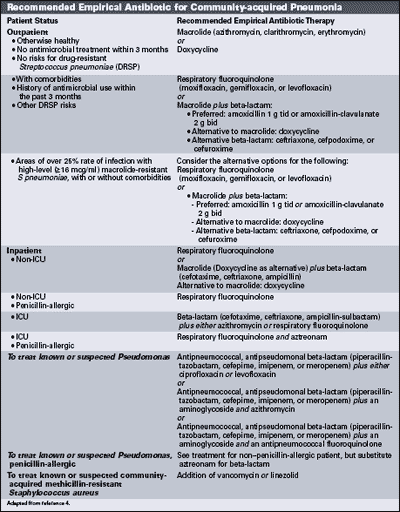Article
A Wrap-Up on CAP
Author(s):
Dr. Holmberg is the pharmacy coordinator at Desert Vista Behavioral Health Center in Mesa, Arizona.

Community-acquired pneumonia (CAP) is classified as an acute lower respiratory tract infection.1 Of all the lower respiratory tract infections diagnosed each year, an estimated 5% to 10% are due to CAP.2 It is responsible for 1.3 million hospitalizations annually in the United States, and its total yearly treatment costs are estimated to be $8.4 billion to $10 billion.3,4 Worldwide, CAP represents the primary cause of death from an infectious agent and the sixth overall cause of death.2 Other outcomes of CAP include increased length of hospital stay, medication toxicity, adverse drug events, microorganism resistance to antibiotics, readmissions, and changes in quality of life and patient satisfaction.4
Diagnosis
Although CAP affects the elderly more frequently, it is important to remember that patients of all ages are susceptible to the disease.1 Diagnosis should be based on both the presence of clinical features (cough, fever, sputum, and pleuritic chest pain) and infiltrate on chest radiograph.4 Patients with CAP may describe other symptoms, such as shortness of breath, rigors, night sweats, or confusion. Additional signs include increased respiratory rate and focal chest signs, such as decreased expansion, dullness to percussion, decreased air entry, bronchial breathing, and crackles.1
Treatment Settings
Treatment of CAP is specific to its setting (outpatients, intensive care unit [ICU] patients, and non-ICU inpatients). Location of treatment can be costly—inpatient costs for CAP are estimated to be 25 times the costs of outpatient care.4 Whether or not to admit a patient for inpatient treatment of CAP depends on clinical judgment, and clinicians may find it helpful to use an objective tool to assess the need for hospitalization. Either a severity-of-illness score, such as CURB-65, or a prognostic model, such as the pneumonia severity index (PSI), may help determine if a patient needs inpatient care.
- CURB-65 assesses 5 criteria: confusion; urea (blood urea nitrogen) >7 mmol/L or 20 mg/dL; respiratory rate >30 breaths/min; blood pressure <90 mm Hg systolic or 60 mm Hg diastolic; and age >65 years. If 2 or more criteria are met, the assessment is considered positive, and the patient should be considered for admission. If laboratory values are not available, an abbreviated assessment may be obtained based on the remaining 4 criteria; it is considered positive if any of the criteria are present.5
- PSI categorizes patients into 1 of 5 mortality risk classes based on age, gender, nursing home status,comorbidities, vital signs, laboratorytests, radiographic evaluations, andoxygenation status.2,4 Outpatienttreatment is considered appropriatefor patients in class I or II. Patients inclass III are recommended for shortstayor observation unit admission.Inpatient admission is recommendedfor patients in class IV or V.4
An admission to the ICU should beconsidered in patients on vasopressorsdue to septic shock or in patients requiringmechanical ventilation as a result oftheir respiratory failure.4
CAP: Identifying Its Cause
Although CAP can be caused by a widerange of organisms, specific pathogensare usually identified and associatedwith it. Common etiologies for outpatientCAP include Streptococcus pneumoniae,Mycoplasmapneumoniae,Haemophilus influenzae, Chlamydophilapneumoniae, and respiratory viruses,such as influenza A and B, respiratorysyncytial virus, and parainfluenza virus.Inpatient CAP in non-ICU patients isoften due to infection with S pneumoniae,M pneumoniae, C pneumoniae,H influenzae, Legionella species, andrespiratory viruses, or as a result ofaspiration. InpatientCAP in ICU patientsis often associated with S pneumoniae,Staphylococcus aureus, Legionellaspecies,gram-negative bacilli, orH influenzae.
Specific diagnostic testing (ie, sputumor blood culture) is not usually recommended for outpatient CAP; however, itmay be warranted for inpatients in morecritical condition.
If organisms are identified, the antibioticregimens should be adapted to targetthe cultured organism as appropriate.
Drug-Resistant CAP
In recent years, drug-resistant S pneumoniae(DRSP) has made the empirical treatmentof CAP more difficult. Patients atgreater risk for DRSP include those whoare <2 or >65 years of age, have receivedtreatment with a beta-lactam or macrolidewithin the past 3 to 6 months, havealcoholism, have comorbidities, are usingimmunosuppressive therapies or have animmunosuppressiveillness, or have hadan exposure to a child in day care.5
CAP resulting from communityacquiredmethicillin-resistant S aureus(CA-MRSA) is still rare, but its incidencehas been increasing lately and is expectedto continue to rise. It has been foundin both adults and children and seems tofollow influenza. Patients with CA-MRSAhave cavitary infiltrates without risk factorsfor aspiration. Both sputum andblood cultures are useful in diagnosis.4
The Pharmacist's Role
Pharmacists can play an important role inboth inpatient and outpatient treatmentof CAP. Areas for pharmacist interventioninclude:
- Monitoring antimicrobial therapy forappropriate treatment according toseverity of disease
- Ensuring correct utilization of anantimicrobial agent based on patienthistory
- Recommending an appropriate antimicrobialagent based either onempirical therapy or in responsetoculture and sensitivity results
- Identifying patients in whom conversionfrom intravenous antibioticsto oral antibiotics may be warranted(hemodynamic stability, clinicalimprovement such as loss offever, improved respiratory status,improved white blood cell count, abilityto take oral medications)5
- Identifying patients at high risk forDRSP based on their medical history
- Counseling patients about theircourse of antibiotic therapy
CAP is a prevalent and potentiallydeadly disease, but it also is one that canbe overcome by appropriate diagnosis,monitoring, and treatment. The pharmacisthas the potential to participate withthe medical team in both an outpatientand inpatient setting to help improvepatient outcomes and restorepatientquality of life.

Table (click on table for larger image)
References
- Hoare Z, Lim W. Pneumonia: update on diagnosis and management. BMJ. 2006;332:1077-1079.
- Armitage K, Woodhead M. New guidelines for the management of adult community-acquired pneumonia. Current Opinion in Internal Medicine. 2007;6:275-281.
- Kanwar M, Brar N, Khatib R, Fakih G. Misdiagnosis of community-acquired pneumonia and inappropriate utilization of antibiotics: side effects of the 4-h antibiotic administration rule. Chest. 2007;131:1865-1869.
- Mandell L, Wunderink R, Anzueto A, et al. Infectious Diseases Society of America/American Thoracic Society consensus guidelines on the management of community-acquired pneumonia in adults. Clin Infect Dis. 2007;44(suppl 2):S27-S72.
- Treatment of community-acquired pneumonia in adults. Available at: www.uptodate.com.
Newsletter
Stay informed on drug updates, treatment guidelines, and pharmacy practice trends—subscribe to Pharmacy Times for weekly clinical insights.





